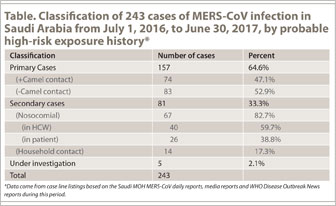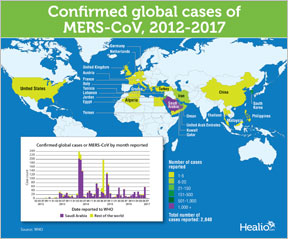MERS-CoV: Waiting for Godot for answers
The Middle Eastern respiratory syndrome coronavirus, or MERS-CoV, has been responsible for sporadic cases of respiratory illness in the Middle East since it was first identified in a fatal case in Saudi Arabia in mid-2012. As with most newly identified illnesses, initial cases had serious disease with a high mortality rate — initially in the 60% range. Those early cases were described as presenting with severe acute respiratory illness associated with renal failure. A retrospective look at an undiagnosed respiratory outbreak in an ICU in Jordan earlier that year (April 2012) also identified MERS-CoV as the etiologic agent.


MERS-CoV has now been known to us for 5 years, and there are still unanswered questions that should have been answered by now. Two years ago, we discussed MERS as doing a “front-burner, back-burner shuffle” in the news cycle and in health sector awareness, having receded to a back burner in the few months following a major outbreak in South Korea. The outbreak was related to an imported case returning to a perfect storm for nosocomial transmission involving multiple hospitals. As of June 2016, MERS-CoV had once again taken a back burner, with only four newly confirmed cases reported during the entire month of May 2016. However, MERS-CoV quickly moved to a front burner with a major nosocomial outbreak in a hospital in Riyadh. In contrast with May 2016, in June 2016 there were a total of 46 cases reported from Saudi Arabia.
So, where are we today in our knowledge base, and more importantly, what control measures do we have? This is of special interest in Saudi Arabia because the country is a main destination for international travel related to business, tourism and pilgrimages.
As of July 21, there have been a total of 2,040 cases of MERS-CoV infection reported to WHO since September 2012, including at least 712 deaths (reported case fatality rate of 34.9%). Cases have been reported from 27 countries around the world — all with the index case originating in the Middle East, with 82% of cases having been reported by Saudi Arabia. The 712 deaths are close to the 724 deaths that occurred in the SARS outbreak of 2002-2003.
In the 1-year period from July 1, 2016, to June 30, 2017, a total of 251 cases of MERS-CoV were reported, of which 243 (97.2%) were reported by Saudi Arabia, three by Qatar, two by the United Arab Emirates (UAE) and one each by Oman, Austria (with travel from Saudi Arabia) and Thailand (with travel from Kuwait). Cases have been classified as either secondary or primary. Secondary cases are related to contact with a laboratory-confirmed case of MERS-CoV infection, whereas primary cases consist of all others including those who have had contact with camels or camel products. As shown in the table, of the 243 cases reported by Saudi Arabia in this period, there were 81 (33.3%) classified as secondary cases. Of these secondary cases, 67 (82.7%) were associated with nosocomial transmission, and 14 (17.3%) were in household contacts. Of the group of 67 nosocomial cases, 40 (59.7%) were in health care workers, 26 (38.8%), were in patients and one (1.5%) was in a hospital visitor.
It is important to note that of the 243 confirmed cases of MERS-CoV infection reported by Saudi Arabia during this period, 46 (18.9%) were asymptomatic contacts of known MERS-CoV-infected individuals. The asymptomatic contacts reported to have MERS-CoV infection included nine household contacts, 31 health care workers and six patients. This increase in reported asymptomatic infections is related to a change in contact testing implemented by the Saudi Ministry of Health (MOH) during this time frame. Previously, the focus for testing was on symptomatic contacts. During this period, the MOH began to test all identified contacts irrespective of clinical symptoms.
Returning to our earlier discussion on the back-burner, front-burner news shuffle, one might wonder about the reason for this shuffle. What has become very apparent is that the shuffle to the front burner is consistently associated with nosocomial transmission.
Nosocomial transmission is usually related to a delayed diagnosis of MERS-CoV infection in a virus shedder in a public venue in a health care setting (a hospital ward, the emergency room or a renal dialysis unit — remembering that the initial description of the clinical presentation included acute renal failure).
So, what about the non-nosocomial transmission? The risk factors for transmission have been contact, either direct or indirect, with camels or camel products such as raw milk, raw meat and raw urine, visiting a health care facility in the 14 days preceding onset of illness (in some instances only if the health care facility had a documented MERS-CoV-infected individual), or contact with a confirmed MERS-CoV-infected individual (in a household or in a health care institution or other location such as a social gathering). Given the relatively high volume of MERS-CoV infections reported by Saudi Arabia, looking at their reported cases and data is helpful. The Saudi MOH defines a primary case as one where there is no identified contact with a known, confirmed case of MERS-CoV infection. This includes the contact with camels described earlier.
To break down the sources in the primary case group, we studied information for the last year. During the period of July 1, 2016, through June 30, 2017, as shown in the table, there were a total of 243 laboratory-confirmed cases reported by the Saudi MOH, of which 157 (64.6%) were classified as primary cases, with 74 (47.1%) of the primary cases associated with contact with camels and 83 (52.9%) with no identified high-risk exposure.
Of the remaining cases, five (2.1%) were still under investigation.
So what additional information has been learned during the last year?
A PubMed search for “MERS” reveals more than 400 articles were published during the 1-year interval. Many of the articles focused on nosocomial outbreaks, with a heavy focus on the nosocomial outbreak in South Korea in May through July 2015. One study from Korea demonstrated a waning serology in humans, especially those presenting with milder symptoms, with the authors concluding that the MERS-CoV incidence was most likely significantly underestimated. One paper presented a single case of asymptomatic infection that exposed 82 contacts, none of whom demonstrated infection — thereby concluding that there was no evidence of transmission of the virus by asymptomatic or mildly infected individuals.
Several studies focused on the prevalence and incidence of MERS-CoV in dromedary camels in the Middle East and North Africa, with the consensus that MERS-CoV is circulating widely throughout North and Eastern Africa, as well as the Middle East. In addition, some of the studies led the authors to conclude that with time there was waning immunity in dromedaries leading to susceptibility for reinfection — a finding that has implications for future vaccination strategies aimed at the dromedary camels. One study demonstrated that although dromedary camels in Kenya had a high seroprevalence of MERS-CoV infection, none of the humans with documented contact with these dromedaries had confirmed evidence of past infection with the MERS-CoV.
A big concern with respect to global health security is the “exportation” of the virus to other countries outside the region with resultant nosocomial transmission, which was seen in the outbreak in Korea in 2015. In that case, it was a returning businessman who had visited multiple countries in the Middle East. The diagnosis was missed during the early days, and to add to the challenges, this individual met the criteria as a superspreader. Other importations have involved returning tourists and pilgrims to Saudi Arabia. International concern has focused more on the hajj, the annual pilgrimage to Saudi Arabia that draws approximately 3 million pilgrims each year. Interestingly, to date there have been no cases of MERS-CoV infection detected among hajji’s returning from Saudi Arabia. In addition to the hajj, there is the “minor” pilgrimage known as umrah, which occurs all throughout the year and involves an estimated 2 to 3 million pilgrims. Since the identification of MERS-CoV, there have been importations of the infection associated with individuals returning from umrah. The disease was imported to Qatar in 2013, to Malaysia, Turkey, Algeria and Iran in 2014, and to Iran in 2015. We speculate that the hajj is not as high a risk as previously thought because there are finite itineraries (hajji’s may not do sightseeing outside of a defined geographic area), there are clear logistics, medical services are hajj-specific because countries bring their own hajj medical teams, and the Saudi MOH has special hajj medical facilities. In addition, camels and camel products are banned from hajj-designated areas. In contrast, those making the umrah pilgrimage have open itineraries, which often include sightseeing throughout the country, including visits to farms, camel rides and sampling camel milk and food made from camel products.
Among the questions that have remained unanswered include one regarding the risk factors for cases without contact with camels or with other confirmed cases of MERS-CoV infection. One small study in Saudi Arabia identified that any contact with other individuals who had direct contact with camels might play a role in transmission in Saudi Arabia. With respect to cases identified in health care workers who were not working in institutions with confirmed MERS-CoV-infected individuals, in some instances further investigations have identified likely undiagnosed MERS-CoV infection in patients these health care workers have cared for.The next burning question is: Why Saudi Arabia? With the numerous studies identifying the high seroprevalence rate of MERS-CoV in dromedary camels in North and Eastern Africa and the Arabian Peninsula, why is it that 82% of all cases were reported by Saudi Arabia? Is this just the outcome of “seek and ye shall find,” and Saudi Arabia is seeking and finding? Or is there something else going on related to animal husbandry and camel contact among the Saudi population different from that seen in other countries?
It is hoped that, in the near future, we will have some answers to these questions. It seems like we are waiting for Godot, who never comes.
- References:
- Alhakeem RF, et al. Emerg Infect Dis. 2016;doi:10.3201/eid2211.161042.
- Ali M, et al. Euro Surveill. 2017;doi:10.2807/1560-7917.ES.2017.22.11.30487.
- Ali MA, et al. Emerg Microbes Infect. 2017;doi:10.1038/emi.2016.130.
- Choe PG, et al. Emerg Infect Dis. 2017;doi:10.3201/eid2307.170310.
- Falzarano D, et al. One Health. 2017;doi:10.1016/j.onehlt.2017.03.003.
- Hemida MG, et al. Emerg Microbes Infect. 2017;doi:10.1038/emi.2017.44.
- Kaye D, Pollack MP. MERS-CoV: The front-burner, back-burner shuffle. https://www.healio.com/infectious-disease/respiratory-infections/news/print/infectious-disease-news/%7Bb1b398d4-d178-4457-9022-256ae1f65a7f%7D/mers-cov-the-back-burner-front-burner-shuffle. Accessed August 14, 2017.
- Meyer B, et al. Emerg Infect Dis. 2016;doi:10.3201/eid2212.160382.
- Miguel E, et al. Euro Surveill. 2017;doi:10.2807/1560-7917.ES.2017.22.13.30498.
- Moon SY, Son JS. Clin Infect Dis. 2017;doi:10.1093/cid/cix170.
- Munyua P, et al. Am J Trop Med Hyg. 2017;doi:10.4269/ajtmh.16-0880.
- ProMED-mail. Novel coronavirus - Saudi Arabia: human isolate. Archive number: 20120920.1302733. http://www.promedmail.org/post/20120920.1302733. Accessed June 15, 2017.
- Saudi Arabia Command & Control Center. MOH: ‘No New Corona Cases Recorded.’ http://www.moh.gov.sa/en/CCC/PressReleases/Pages/statistics-2017-07-03-001.aspx. Accessed August 14, 2017.
- van Doremalen N, et al. Vector Borne Zoonotic Dis. 2017;doi:10.1089/vbz.2016.2062.
- WHO. Emergencies preparedness, response; Middle East Respiratory Syndrome Coronavirus (MERS-CoV) – Saudi Arabia. http://www.who.int/csr/don/19-june-2017-mers-saudi-arabia/en/. Accessed August 14, 2017.
- Zaki AM, et al. N Engl J Med. 2012;doi:10.1056/NEJMoa1211721.
- For more information:
- Donald Kaye, MD, MACP, is a professor of medicine at Drexel University College of Medicine, associate editor of the International Society for Infectious Diseases’ ProMED-mail, section editor of news for Clinical Infectious Diseases and an Infectious Disease News Editorial Board member.
- Marjorie P. Pollack, MD, is deputy editor of ProMED-mail and an independent consultant medical epidemiologist with a focus on developing world issues following CDC training. She is based in New York.
Disclosures: Kaye and Pollack report no relevant financial disclosures.



